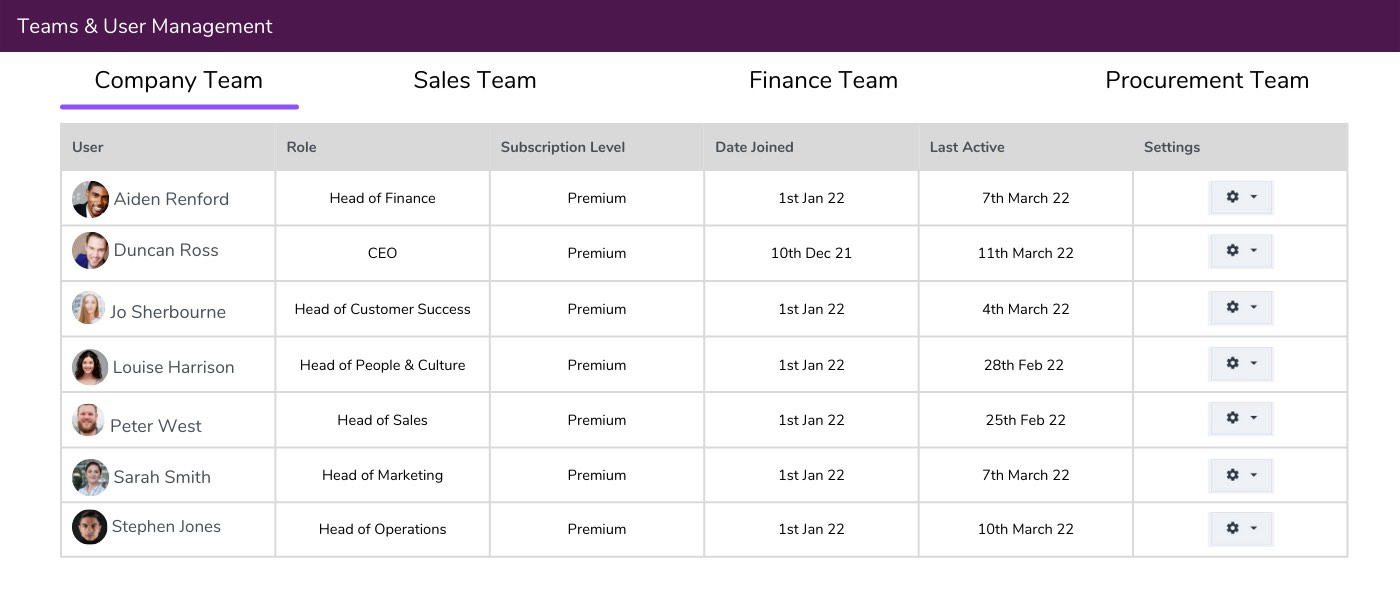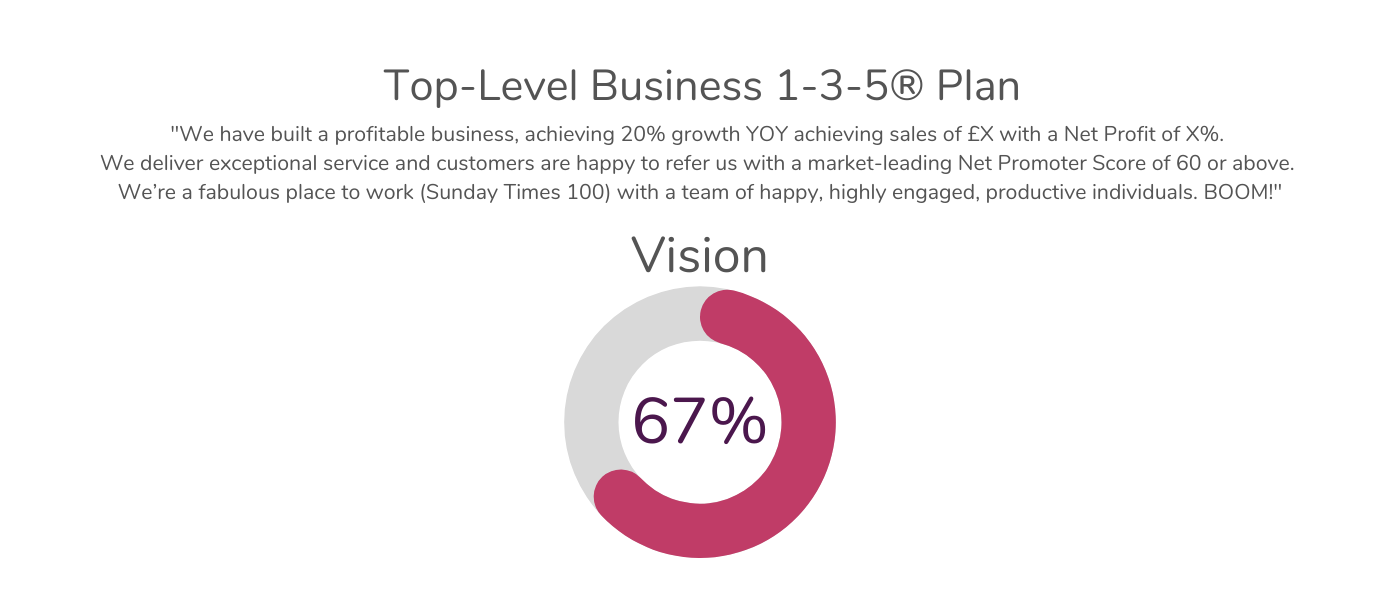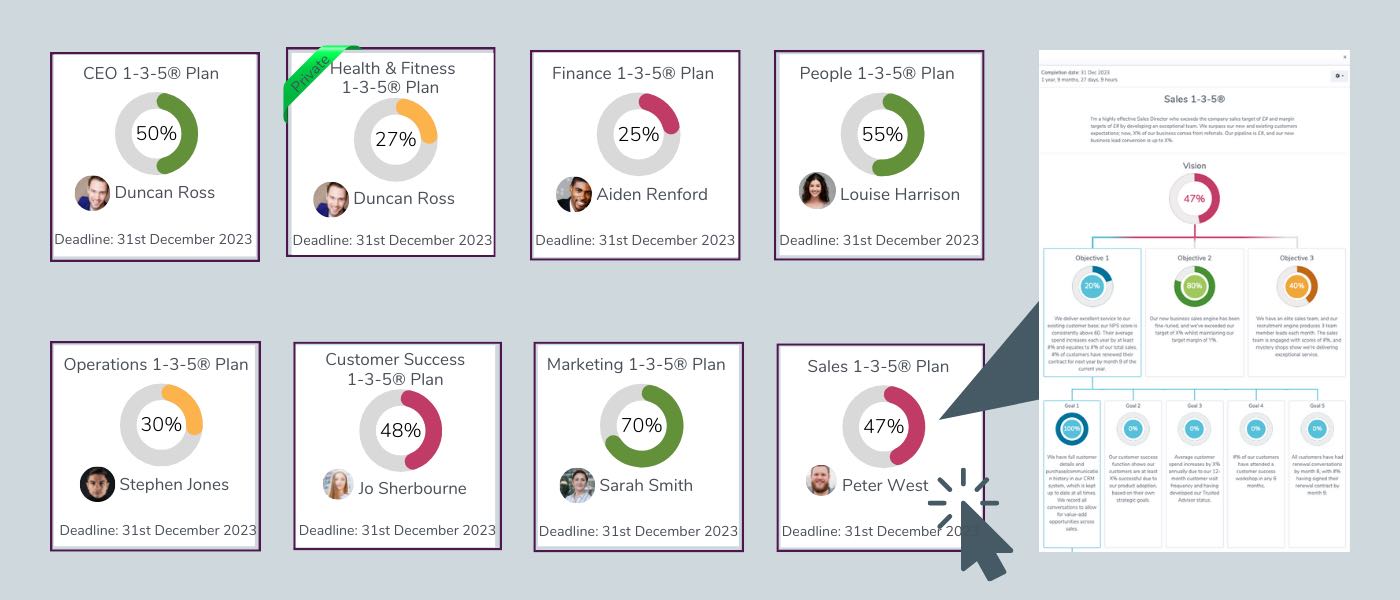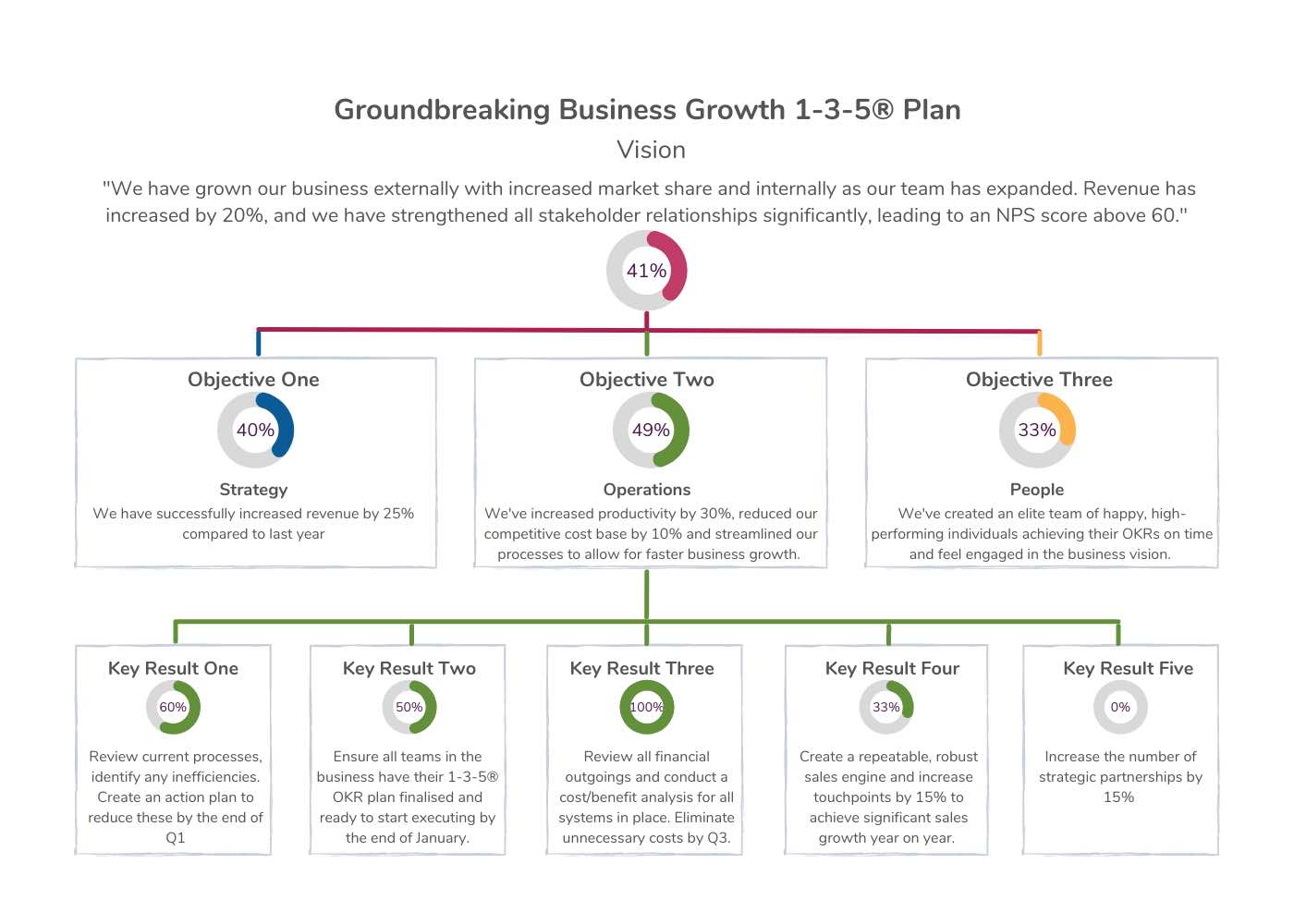
Last updated 25 March 2022 ·

As a business leader, you’ll know the importance of running a team, meeting targets and ensuring your business reaches its goals. It’s vital to keep track of all that’s going on, but sometimes it can be somewhat challenging to oversee everything all at once. This is where OKRs, objectives and key results come in to help you make the most of your resources and increase productivity. With the use of OKRs, you can begin goal-setting, effectively making the most of your time, efforts and team.
Every member of your team helps contribute to the success of your business, and ideally, everyone must understand their role, responsibilities and how they can impact this the most. OKRs allow you and your team to become more aligned, as they enable you to see how your employees are performing and keep track of everyone’s workload. Because of this, OKRs, objectives and key results provide such a robust goal-setting framework that helps you achieve your business vision.
OKRs provide your business with five important elements: focus, accountability, engagement, transparency and visibility.
Before we can delve into how you can implement an OKR, objectives and key results framework, it’s best that you understand everything you need to know about them first. In this post, you’ll learn exactly what OKRs, objectives and key results are, their importance and their business benefits. Additionally, we’ll be discussing the disconnect between strategy formulation and execution. You’ll be able to see real-life OKR examples and delve into one of our case studies. We even provide tips on how to cascade OKRs effectively throughout your entire business. By the end of this article, you’ll be prepared to start creating your OKRs and become an expert in effective goal-setting and performance management. Read on to begin your OKR adventure and discover how you can accelerate results in your business.
Contents
- OKRs, objectives and key results: what are they?
- The importance of OKRs, objectives and key results
- What are the business benefits of OKRs, objectives and key results?
- Focus
- Accountability
- Engagement
- Transparency
- Visibility
- When are OKRs not a good fit?
- Unwillingness to change
- Issues with setting appropriate goals
- Setting and forgetting goals
- How to effectively implement OKRs, objectives and key results in your business
- Start with setting your objective
- Devise key results to measure your success
- Reclaro's OKR templates
- Case Study: Nock Deighton
- Client mission
- The growing challenge
- The Reclaro solution
- The key result
- Introducing our award-winning 1-3-5® OKR planning tool
- What exactly is a 1-3-5® plan?
- OKRs, objectives and key results: everything you now know in summary.
OKRs, objectives and key results: what are they?
Firstly, let’s begin with the acronym OKR: it stands for objectives and key results. OKRs are a practical goal-setting framework that helps achieve accountability, stronger focus, better engagement, and complete transparency and visibility within a business. In its simplest form, the idea behind this highly effective goal-setting framework of OKRs is that the strategic objectives are clearly defined and divided into measurable key results for individuals to work towards. These measurable steps will demonstrate the progress of each objective.
Andy Grove developed the concept of OKRs in 1968 during his time working for Intel. During his time with Intel, revenue increased from $1.9 billion to $26 billion; such an increase wouldn’t have been possible without the implementation of OKRs! Grove believed in the value of every single employee and pushed for workers to be responsible for setting their own goals. OKRs enable workers to be valued for their accomplishments within their role and not their background, degree, or title.
OKRs, objectives and key results help accelerate growth and maintain a strong focus as teams expand. The concept is simple: you’ve got a single vision with clear objectives, and those objectives are cascaded out and measured using key results. Objectives are what you want to achieve, and the key results are how you’re going to achieve them. That’s it; it really is that simple.
You might be thinking, “hang on, is an OKR not the same thing as a KPI?” Although they sound similar, they are different. KPI stands for key performance indicator, and they are a standalone measurement of achievement. In contrast, OKRs are structured and more strategic planning that can cascade throughout an entire business.
Read more information on how KPIs and OKRs are different and which will work best for you.
The importance of OKRs, objectives and key results
Now that you know what OKRs are, let’s explore their importance. OKRs can be implemented at any level; this could be at a company, team or individual level. This kind of system enables teams to collaborate and offers a high degree of visibility of roles and responsibilities. Implementing cascading OKRs removes any chance of misalignment between teams as the key strategic focus and priorities are tight and consistent. Such close focus means employees and departments are aware of the bigger picture allowing them to work together towards achieving the same goal. OKRs, objectives and key results will alter how each team member approaches their daily tasks, helping them become more efficient, effective, organised and prepared for the day ahead.
OKRs allow business leaders to centralise focus and cascade key business priorities from the CEO level throughout all layers of an organisation. Being at the centre of the OKR system plays a huge role in ensuring teams are fully aligned and working effectively together to achieve faster results. In Measure What Matters, John Doerr explains that: “OKRs are a shared language for execution. They clarify expectations: What do we need to get done (and fast), and who’s working on it? They keep employees aligned, vertically and horizontally.” As John notes, OKRs provide a structured way to effectively communicate your business vision and direction, encouraging appropriate action in the right direction.
Additionally, as well as setting goals, OKRs can help improve the structure of annual reviews and regular 1-2-1 meetings to ensure goals and targets are being met and allow you to form a stronger professional relationship with your employees. OKRs also help employees set realistic expectations of roles and responsibilities, empowering them to make more effective decisions and therefore make more of an impact as they understand the bigger picture. Regularly working towards clearly established OKRs allows the time spent during 1-2-1 to become more efficient and effective as you’re able to assess accurate, real-time performance from each individual. The image below shows the Reclaro Teams and User Management dashboard, displaying information about each team member. This information includes their last activity date, allowing leaders to see who is most active and regularly tracking progress towards their OKRs, keeping everything up to date:

What are the business benefits of OKRs, objectives and key results?
Now that you know what OKRs are and why they’re important, it’s time for you to learn about their benefits. OKRs are great, and there is a wide range of benefits that OKRs can bring to your business. They can enhance focus, accountability, transparency, engagement and visibility. OKR software helps embed OKRs deeper within an organisation’s culture and provides a well-structured, consistent method of logging regular progress.
Read on to learn more about how each of these critical benefits contributes to the success of your business.
Focus
Focus is the primary benefit of OKRs, objectives and key results; the entire ethos is built around it.
Having an overall vision to work towards provides the focus for your entire team. We advise setting your vision and objectives as if you’ve already achieved them. Here is an example of a vision statement:
Vision: We have grown our business externally with increased market share and internally as our team has expanded. Revenue has increased by 20%, and we have strengthened all stakeholder relationships significantly, leading to an NPS score above 60.
The cascading nature of OKRs allows every member of your team to see your vision. When you cascade your business priorities from the top throughout all departments to frontline employees, you are including everyone within your plan, allowing them to see precisely how their priorities and daily tasks contribute to the bigger picture. Such transparency allows for a much tighter focus from every employee, giving them a constant reference point and something to aim for. The following image shows the percentage completion towards achieving the vision set out within a 1-3-5® plan:

Accountability
OKRs provide an easy way to align and empower your workers; you’ll be able to see exactly who’s on track instantly and achieving their objectives as they should be, as well as those that may need help to progress. On top of this, OKRs give frontline people the opportunity to better understand the work they’re doing and why they’re doing it because they can easily see the bigger picture your business is working towards and take ownership of their projects.
By seeing colour coded percentage dials as numerical indicators, you’re able to instantly identify the level of progress being made at any one time and assess how impactful your team efforts have been. The following visual shows you the live performance dashboard indicating the live progress of each senior team leader within the business as a precise percentage towards achieving everything set out within their OKR plan against the timescale they set for full plan completion:

Engagement
We understand how easy it is to get lost under ever-demanding workloads when you’re scaling your business. Effective communication can become more challenging as you no longer have direct contact with every team member as you grow. Without a clear, well-structured business plan and clear communication channels, you risk frequent misunderstandings and misalignments emerging. Perhaps frontline workers cannot quite understand what they’re working towards, which is time-wasting. They come to work, do what they’re told, leave again, and repeat the next day without any level of understanding, ownership or engagement in the overall business purpose. When your team is multiplying, it’s essential to establish a quick reference point that allows you to accurately see whether you are winning or not through live performance across all teams.
By implementing OKRs, objectives and key results within your business, you allow your employees to see the bigger picture, giving both new and more established employees a better idea of what your business is all about and ultimately what you are trying to achieve. Having clearly defined OKRs removes any element of confusion and helps to engage all teams in your purpose and vision for the business.
Research shows that OKRs can have a positive effect on employee engagement as well as team morale. The nature of OKRs allows employees to visualise how their hard work impacts overall business performance, and seeing the impact of their contribution gives them a higher sense of achievement. By sharing your vision with your employees, they are more likely to feel important, valued, and empowered to take ownership as they consider for themselves how they can make more of an impact. For guidance on how to improve your employees’ engagement check out our blog article: Improve employee engagement with five everyday leadership practices.
OKRs help senior leaders and managers organise their teams’ workload whilst ensuring everyone is working effectively towards achieving the overall business vision. Here’s an example of an objective that focuses on the people within your organisation and three key results which will help achieve it:
Objective (People): We’ve created an elite team of happy, high-performing individuals achieving their OKRs on time and feel engaged in the business vision.
Key Result 1: Review all team/individual OKR plans and performance across the board quarterly to ensure they are on track.
Key Result 2: Action any areas of concern by providing further training and development where needed within each quarter.
Key Result 3: Identify strong individuals for promotion opportunities and implement a structured employee recognition scheme by the end of Q2.
Transparency
OKRs provide transparency of roles, responsibilities, goals and achievements, from the CEO to frontline employees through alignment towards the overall business vision. The benefits transparency can bring to your business are more clarity across the entire organisation, smarter decisions, and increased team alignment and engagement.
Using a software system to monitor your OKRs, objectives and key results can be hugely beneficial, providing real-time progress updates and an accurate picture of productivity. Such systems work effectively to keep you up-to-date and aware of what people are working on and if they will meet deadlines on time. Such transparency of roles and responsibilities fosters higher levels of trust and respect within the team. What’s more, if you have distributed teams, OKRs allow you to stay up-to-date with how those remote workers perform, making the hybrid working model more accessible than ever.
For instance, here’s a snapshot of our OKR platform showing a clear overview of each team member’s overall progress and performance to date. Clicking on any one of these top-level performance dials brings up their detailed 1-3-5® OKR plan so you can take a deep dive and see exactly where they have made progress.

Visibility
As OKRs, objectives and key results allow you to see all of the progress your teams are making, you’ll be able to identify which teams are the most focused, committed and effective in their work. This visibility of progress, performance, and achievement helps recognise rising stars and facilitates an effective employee recognition scheme allowing for recognition where it’s due.
Have you ever done something you were proud of but perhaps it was overlooked, or credit was given to someone else? This can be very disheartening. OKRs can eliminate this problem. An employee recognition scheme provides positive reinforcement, motivating workers to achieve their goals, thus moving your business closer to achieving your vision. If your employees feel appreciated, they’ll want to deliver the best work for you. Real-time visibility of whole team performance allows this to happen.
For more information on this, check out our blog Employee Recognition - a simple action with massive benefits which covers all areas of employee recognition and its benefits.
When are OKRs not a good fit?
OKRs are suited to goal-oriented businesses that are ambitious, geared towards high performance and either growing fast or eager to achieve a faster pace of growth. OKRs aren’t for every business, and that’s 100% okay! Although the idea of OKRs, objectives and key results is simple, some companies find it challenging to implement a new structure in their already set-in-stone business system.
There are many reasons why OKRs aren’t compatible with specific businesses. The big three are:
- Unwillingness to change
- Setting appropriate goals
- Setting and forgetting
Unwillingness to change
Some people, as well as businesses, are simply not accustomed to change. They’re set in old ways of thinking and notions of success. It’s essential to approach OKRs, objectives and key results with an open mind and enthusiasm. You need to understand OKRs fully and be excited about them. We recommend that the CEO or MD of a business implement top-level OKRs initially because it makes it easier to cascade these OKRs throughout an entire organisation effectively.
Check out our blog post on how to drive positive change in your business, which provides help and guidance on managing change and getting your team fully on board with OKRs.
Issues with setting appropriate goals
OKRs are a simple concept; however, they won’t fix every problem under the sun. The critical thing to remember is that the more detailed, clear and concise your vision, objectives and key results are, the better your outcome will be. “Vague focus produces vague results” There’s no room for broadness, and you have to be as specific as possible with every single objective you set. Keep the following in mind when developing your OKRs:
- Significance
- Clarity
- Action-orientated
- Measurable
If your OKRs don’t align with these three things, you could be setting yourself up for failure.
Setting and forgetting
It’s pretty standard for people to start setting goals with good intentions, but as we know, life happens, and all of a sudden, things get forgotten. A struggle some business owners find themselves in is a real disconnect between strategy formulation and execution. You can form a strategy, but if you’re not executing it correctly, you’re wasting your time. Having a rough plan can only get you so far; however, OKRs, objectives and key results allow you to organise the finer details of each plan and enable you to cascade a tight strategic focus throughout your entire team. Your objectives will become more apparent, and you can implement them effectively with this goal-setting framework.
Implementing a structured OKR system throughout your team should become part of your everyday working culture. OKRs help you track progress and stimulate ambition to achieve ambitious goals, so make sure you review OKRs during 1-2-1s and any project update meetings.
We recommend that you begin checking in with your structured OKR plan at the beginning and end of each day. This will ensure you’re keeping an eye on your progress whilst making it part of your daily routine. Encouraging your team to do the same will keep you all focused and on track. We discuss several ways to help you avoid setting and forgetting goals in our blog post-OKRs: How to set and not forget.
Read about other things that can make your business incompatible with OKRs.
How to effectively implement OKRs, objectives and key results in your business
The implementation of OKRs must begin at the top of your organisation with the business leader. Start from the top with the overall vision and cascade the objectives outwards that will then be broken down into key results and further adapted according to each department. As you supercharge your business vision, creating something inspiring yet straightforward and easy to understand, it’ll work in your best interest if you begin the goal setting.
The idea is that what you set at the top is then cascaded throughout all of your teams. It’s essential to make sure your top-level OKRs, objectives, and key results are precise, easy to understand, memorable, and aligned with your organisation’s overall vision.
Start with setting your objective
You need to sit down and begin thinking about your business vision. A business objective can be as simple as achieving 20% growth year on year or becoming the market leader within your industry; as long as there’s a unified view of the outcome, anything can be achieved. Now that you’ve got your vision, you may wish to work with your senior leaders to finalise the objectives required to achieve it. These objectives will then carry forward for implementation across your business.
The next step involves all teams creating suitable strategies to achieve each of these objectives. It’s essential to include the senior leadership team to contribute and help steer the business in the right direction by identifying where and how their teams can make the most significant impact. Remember, the objectives are what you want to achieve, and the key results provide detailed and specific measures of how to accomplish each of the objectives.
Here is an example of an objective that focuses on business strategy:
Objective 1: We have successfully increased revenue by 25% compared to last year.
Devise key results to measure your success
Now that you’ve set your objectives, it’s time to focus on the key results. Your key results should be measurable points that indicate progress and success towards each of your objectives. By having quantifiable goals within your plan, your team can stay focused, and you can measure the progress towards each of the objectives and the business vision. Your key results must be achievable, measurable and aspirational.
Here’s an example of an objective with three key results below it:
Objective: Achieve recognition as the most sustainable business in our industry.
Key Result 1: Reduce fleet emissions by switching to 75% ultra-low emission vehicles.
Key Result 2: Use only 100% recyclable product packaging.
Key Result 3: Achieve 95% paperless invoicing by the end of the year.
As you can see, there’s a clear set objective and three key results that break down the steps required to achieve it. The clearer your goals, the faster you’ll achieve them. Your OKRs should be set over a specific timeframe; we usually recommend 6 to 12 months. The way your OKRs cascade is vital to the success of the implementation.
Here is another example of how an objective can be broken down into key results:
Objective 1: We have successfully increased revenue by 25% compared to last year.
Key result 1: Generate 10,000 sales a month.
Key result 2: Offer services in 15 more countries, i.e. America.
Key result 3: Reduce operating costs by 20% from the previous year by reviewing suppliers, finance, premises and production.
For further tips on goal setting, read our blog post: Goal setting tips for faster business growth.
Reclaro’s OKR templates
Many people have their way of implementing OKRs within their business. The award-winning 1-3-5® business planning methodology we use at Reclaro structures OKRs effectively to ensure a tight focus and avoid overwhelm. We share more insight into this methodology after the case study below.
To see precisely how OKRs are written in the real world, we created seven free downloadable templates, each corresponding with a different area of specialism such as sales, marketing and HR that you can use to help you get started. Download your free 1-3-5® OKR templates and examples.
We’ve worked with many businesses to implement an effective OKR system following our 1-3-5® business planning methodology. To show you exactly how OKRs, objectives and key results can benefit your business, we’ve shared some of our client success stories. Here’s one we’re particularly proud of.
Case Study: Nock Deighton
Client mission
Nock Deighton is a highly accredited estate agent operating across nine offices throughout the Shropshire and Worcestershire regions. Their dedicated team of industry experts bring together a vast array of qualifications and decades of professional experience to ensure they maintain a firm focus on achieving the very best results for their clients.
The growing challenge
Nock Deighton faced the challenge of achieving effective communication as the business grew and more offices were open across several locations. It was becoming difficult to coordinate within the different teams, and misalignment with the overall business direction began to occur. The Chairman, Michael Nettleton, described their issue as:
Our main challenge was communication and the lack of a consistent approach to communicate the business plan effectively amongst our distributed teams.
As you know, effective communication within teams is vital, so this challenge was a priority for us to help Michael and his growing business solve.
The Reclaro solution
We introduced our 1-3-5® OKR performance system to Michael, which he then implemented, allowing him to clarify his vision and centralise focus towards the fundamental actions required to achieve his business vision.
Michael identified that this OKR, objectives and key results solution could effectively solve his communication challenges and help centralise focus on key business objectives within his distributed teams. Michael rolled out the Reclaro 1-3-5® OKR software across his entire business and began cascading his vision, objectives and key results, effectively enabling his senior leaders and managers to work on their digital 1-3-5® plans and focus on objectives that would drive the business forward. Establishing OKRs and cascading them throughout his business allowed Michael to immediately see an accurate picture of whole team performance and achievement via the Team Overview Dashboard. Here’s what Michael had to say about this OKR system:
Reclaro provides the simple digital platform we need to enable us to have a clearly defined business plan, against which we can track milestones and ensure we are making progress at both a team and individual level.
The key result
Michael and his teams at Nock Deighton have found the 1-3-5® OKR software highly effective for business planning and communication, especially in recent times of working remotely due to COVID-19. A final word from Michael:
We have created specific objectives and goals to move the business forward dramatically, which are cascaded effectively throughout the whole organisation. Our regional teams are a lot more aligned and highly focused on key priorities with continuity, which drives progress and improves performance.
Check out more of our customer stories on our website.
Introducing our award-winning 1-3-5® OKR planning tool
Reclaro’s award-winning 1-3-5® business planning methodology helped Nock Deighton achieve their business vision, and it can help you achieve yours too. The 1-3-5® business planning methodology provides a clear structure and perfectly aligns with the goal-setting framework of OKRs, objectives and key results. This planning structure allows you to implement OKRs into your business seamlessly.
What exactly is a 1-3-5® plan?
1 Vision
The one in 1-3-5® is the overall vision for the business. The vision statement should be crystal clear, easy to understand and inspiring! The vision will be shared with the whole organisation; everyone must know what they’re working towards. A business vision is usually centred around growth or market domination.
3 Objectives
The three in 1-3-5® refers to the three main objectives that ultimately help achieve the vision. Again, these need to be as clear and as straightforward as possible. These objectives usually include vital areas such as strategy, operations, and people at the leadership level.
5 Key Results
The five in 1-3-5® refers to the five key results that will help achieve each of the three main objectives. The key results should be specific, measurable and timely as they show the progression towards completion. The key results are the tactical nitty-gritty details of the OKR system; you won’t achieve your vision without them.
The whole idea of 1-3-5® planning is about being super clear about where to focus your efforts. A solid and clear structure is at the heart of our methodology. Read more about writing leadership OKRs with 1-3-5®.
Here is a detailed example of an OKR in the 1-3-5® format for you to take inspiration from:
Vision: We have grown our business externally with increased market share and internally as our team has expanded. Revenue has increased by 20%, and we have strengthened all stakeholder relationships significantly, leading to an NPS score above 60.
Objective 1 (Strategy): We have successfully increased revenue by 25% compared to last year.
Key result 1: Generate 10,000 sales a month.
Key result 2: Offer services in 15 more countries i.e. America.
Key result 3: Reduce operating costs by 20% from the previous year by reviewing suppliers, finance, premises and production.
Key result 4: Review all current product and service pricing and adjust accordingly to remain competitive. The new pricing is to be finalised by the end of Q3.
Key result 5: Implement an up-selling strategy and initially target our middle range customers to maximise those accounts by the end of Q3.
Objective 2 (Operations): We’ve increased productivity by 30%, reduced our competitive cost base by 10% and streamlined our processes to allow for faster business growth.
Key Result 1: Review current processes and identify any inefficiencies revealed. Create an action plan to reduce these by the end of Q1.
Key result 2: Ensure all teams in the business have their 1-3-5® OKR plan finalised and ready to start executing by the end of January.
Key result 3: Review all financial outgoings and conduct a cost/benefit analysis for all systems in place. Assess the business need and eliminate any unnecessary costs by Q3.
Key result 4: Create a repeatable, robust sales engine and increase touchpoints by 15% to achieve significant sales growth year on year.
Key result 5: Increase the number of strategic partnerships by 15%.
Objective 3 (People): We’ve created an elite team of happy, high-performing individuals achieving their OKRs on time and feel engaged in the business vision.
Key Result 1: Review all team/individual OKR plans and performance across the board quarterly to ensure they are on track.
Key Result 2: Action any areas of concern by providing further training and development where needed within each quarter.
Key Result 3: Identify strong individuals for promotion opportunities and implement a structured employee recognition scheme by the end of Q2.
Key Result 4: Ensure all employees work on their development plans, are regularly offered training opportunities and are made aware of career progression opportunities ready for mid-year appraisals.
Key Result 5: Develop a confidential feedback scheme where employees can make suggestions on how we continually improve our environment, team and performance. Ready to launch at the start of Q3.
For more OKRs, objectives and key results examples, check out our blog post: OKR examples to help you get started.
Here is a visual of our 1-3-5® planning system in action:
 Suppose you’re looking for help with writing the perfect OKRs, objectives and key results you can download a free copy of our workbook entitled The OKR Builder™. In that case, it’ll help you write compelling OKRs that cascade successfully throughout your business.
Suppose you’re looking for help with writing the perfect OKRs, objectives and key results you can download a free copy of our workbook entitled The OKR Builder™. In that case, it’ll help you write compelling OKRs that cascade successfully throughout your business.
OKRs, objectives and key results: everything you now know
OKRs, objectives and key results can enrich your business. They’ve helped huge companies such as Google, Spotify and others reach where they are today. But you don’t need to be a famous business to reach maximum potential; what you need are OKRs. Google first began using OKRs when they employed just 40 staff, and using OKRs has helped them grow significantly to where they are today with well over 100,000 employees.
Our OKR software will have you organised, focused and ready to take on your next business challenge within no time at all. Book a free personalised demo with Reclaro Founder and CEO Pete Wilkinson for more information.
Wondering what OKRs would look like at a granular level for your senior leaders?
We have created 8 x OKR template plans using the award-winning 1-3-5® structure, covering each of the main senior leadership roles, commonly found in most businesses, such as CEO, Head of Sales, Head of Marketing, Head of Finance, etc, including real-world examples of senor level objectives and key results. This free download also includes a Health and Fitness template plan and a blank/editable template you can use to get started creating your own OKRs. Click the button below to download these templates and get started today.





